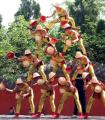CONTACT US
| +86-10-82600771 | |
| WhatsApp: +86-13911460247 | |
| Messenger: chinatournet | |
WeChat ID: callchinatour | |
Pekjing Opera
Peking opera of China is a national treasure with a history of 200 years. In the 55th year of the reign of Emperor Qianlong of the Qing Dynasty(1790) ,the four big Huiban opera Troupes entered the capital and combined with Kunqu opera, Yiyang opera, Hanju opera and Luantan in Beijing's thearetical circle of the time. Through a period of more than half a century of combination and integration of various kinds of opera there evolved the present Peking opera, the biggest kind of opera in China, whose richness of repertoire, great number of artists of performance and of audiences, and profound influence are incomparable in China.
Peking opera is a synthesis of stylized action, singing, dialogue and mime, acrobatic fighting and dancing to represent a story or depict different characters and their feelings of gladness, anger, sorrow, happiness, surprise, fear and sadness. In Peking opera there are four main types of roles: sheng (male) dan (young female), jing( painted face,male), and chou (clown, male or female). The characters may be loyal or treacherous, beautiful or ugly, good or bad, their images being vividly manifested.
The repertoire of Peking opera is mainly engaged in fairy tales of preceding dynasties, important historical events, emperors, ministers and generals, geniuses and great beauties, from the ancient times to Yao, Shun, Yu, the Spring and Autumn Period, the Warring States Period and the dynasties of Qin, Han, Sui, Tang, Song, Yuan, Ming, Qing.
The music of Peking opera is that of the "plate and cavity style".Its melody with harmonious rhythms is graceful and pleasing to the ears. The melody may be classified into two groups: "Xipi" and "erhong", guiding pattern, original pattern, slow pattern, quick pattern, desultary pattern being their chief patterns. The performance is accompanied by a tune played on wind instruments, percussion instruments and stringed instruments, the chief musical instruments being jinghu (a two-stringed bowed instrument with a high register), yueqin( a four-stringed plucked instrument with a full-moon-shaped sound box), Sanxian( a three-stringed plucked instrument), suona horn, flute drum, big-gong, cymbals, small-gong, etc.
The costumes in Peking opera are graceful, magnificent, elegant and brilliant, most of which are made in handicraft embroidery. As the traditional Chinese pattern are adopted, the costumes are of a high aesthetic value.
The types of facial make-ups in Peking opera are rich and various, depicting different characters and remarkable images, therefore they are highly appreciated. Moreover there are numerous fixed editions of facial make-up.
Since Mei Lanfang, the grand master of Peking opera, visited Japan in 1919, Peking opera has become more and more popular with people all over the world, and it has made an excellent contribution to cultural exchange between China and the West, to friendly association and to improvement of solidarity.
Peking Opera house of Beijing has been invited to perform in U.S.A., England, France, Germany, Italy (three times), Australia, Japan( four times), Brazil, Turkey, Singapore, South korea and Hongkong (five times). The performances have made an outstanding contribution to Sino-foreign cultural exchange and to the promotion of friendly association of peoples in the world, and were highly appreciated by foreign audiences.



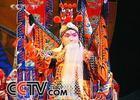
Chinese Kungfu
Anyone who has seen classical Chinese Kung Fu movies will be deeply impressed by the Chinese Wushu, which is called Kung Fu or Chinese martial arts in the west.Wushu (also known as kung-fu or martial arts) is one of the typical demonstrations of traditional Chinese culture. It is a sport which utilizes both brawn and brain.
The theory of Wushu is based upon classical Chinese philosophy, while the skills of Wushu consist of various forms of fighting: fist fights, weapon fights, and other fighting routines (including such offence and defence acts as kicking, hitting, throwing, holding, chopping and thrusting) and unarmed combats.
Wushu is not only a sporting exercise but also an artistic form. It is used to cure illness as well as for self-defence and is a comprehensive form of culture of the human body.
Literally, wu means military while shu means art, thus Wushu the art of fighting or martial arts. Wushu is an important and unique component of Chinese cultural heritage with centuries of cultural history attached. Wushu not only includes physical exercise but also Chinese philosophy, meditation and aesthetics.
Wushu enjoys a long history and great popularity in China. Thanks to its uniqueness and charisma originating from traditional oriental culture, Wushu is captivating the attention of more and more people in other nations.
In the past, Wushu was developed for the sake of military prowess and physical well being. Wushu was seen as crucial to a soldier's survival in the time of hand -to -hand combat. Today, military function has faded and it has been organized and systematized into a formal branch of study in the performance arts by the Chinese, while it's physical welfare and athletic functions become dominant. Hence Wushu is popular among the whole nation of China, practiced by men and women, young and old alike. Today many people practice Wushu to pursue health, defense skills, mental discipline, entertainment and competition.
Wushu can be practiced solo, paired or as a group, barehanded or armed with ancient Chinese weapons. In centuries past, Wushu developed into many systems and styles. The most famous systems include Shaolin Temple system and Mt. Wudang System. Only the Shaolin system has hundreds of styles. Among the many styles are Chang quan (long fist), Nan quan (southern fist), Taiji quan (shadow boxing or supreme ultimate fist), Xingyi quan (mind fist), Baqua quan (eight directions fist). The former two belong to the external style which emphasizes physical strength and abilities while the latter three belong to the internal style that depends upon internal power-qi. The ancient weaponry of Chinese Wushu consists of many represented by 18 named weapons.
Recently, Chinese Wushu has been modernized. Training and competing standard systems have been set up. Continuing its fighting function, Wushu becomes a more athletic and aesthetic performance and competitive sport. More and more foreigners come to learn the mysterious Wushu. Wushu is now to be a sport of the Olympic Games soon.
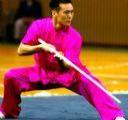
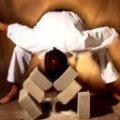
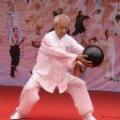
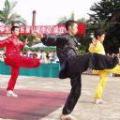

Acrobatic Show
Acrobatics is an interactive art form. Whether you are old or young, educated or illiterate, you can appreciate it as long as you can see. There is no language barrier and cultural border.
The history of acrobatics in China can be traced back to Neolithic times. It is believed that acrobatics grew out of the labor and self-defense skills that the people practiced and demonstrated during their leisure time.
By 300 BC, such skills as walking on 3-meter high stilts and juggling 7 daggers at a time had been developed in China.
As the world economy developed, acrobatics was also developed into a kind of performance art. Acrobatics became known worldwide through performances presented along the Silk Road.
In Europe and North America, Chinese acrobatic performances attract large audiences.
A high level acrobatic program needs excellent technique coaches and much preparation time before it is ready to be performed in public.
Acrobatic art has its own peculiarity. The performance itself is very depictive; therefore the requirement for lighting is much stricter than opera and drama.
The theme music perfectly coincided with the performance, which made the atmosphere of the event even livelier. However, before the rehearsal, the performer gave the director a lot of trouble.
Chinese acrobatic art is still what it was centuries ago in that it does not over emphasize the role of music. Performers pay more attention to action. Therefore it takes time for performers to adapt to the music.
A successful acrobatic show also requires appropriate clothing. Costumes further enhance the beauty of the performance and increase the visual effects.
When you watch a Chinese acrobatics show, you are strongly impacted both mentally and physically. It is truly and unforgettable experience.

